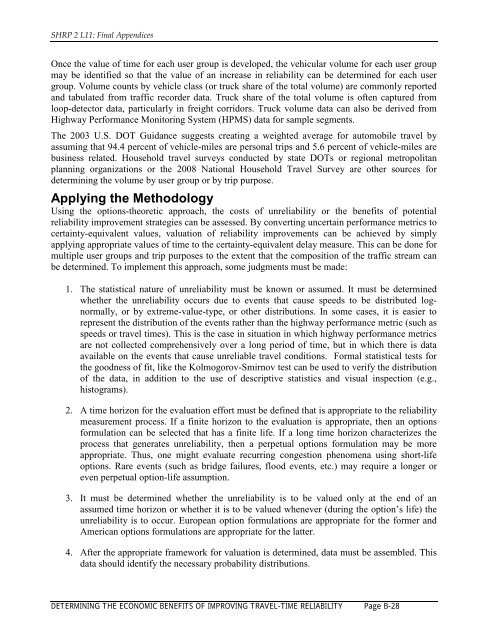Evaluating Alternative Operations Strategies to Improve Travel Time ...
Evaluating Alternative Operations Strategies to Improve Travel Time ...
Evaluating Alternative Operations Strategies to Improve Travel Time ...
You also want an ePaper? Increase the reach of your titles
YUMPU automatically turns print PDFs into web optimized ePapers that Google loves.
SHRP 2 L11: Final Appendices<br />
Once the value of time for each user group is developed, the vehicular volume for each user group<br />
may be identified so that the value of an increase in reliability can be determined for each user<br />
group. Volume counts by vehicle class (or truck share of the <strong>to</strong>tal volume) are commonly reported<br />
and tabulated from traffic recorder data. Truck share of the <strong>to</strong>tal volume is often captured from<br />
loop-detec<strong>to</strong>r data, particularly in freight corridors. Truck volume data can also be derived from<br />
Highway Performance Moni<strong>to</strong>ring System (HPMS) data for sample segments.<br />
The 2003 U.S. DOT Guidance suggests creating a weighted average for au<strong>to</strong>mobile travel by<br />
assuming that 94.4 percent of vehicle-miles are personal trips and 5.6 percent of vehicle-miles are<br />
business related. Household travel surveys conducted by state DOTs or regional metropolitan<br />
planning organizations or the 2008 National Household <strong>Travel</strong> Survey are other sources for<br />
determining the volume by user group or by trip purpose.<br />
Applying the Methodology<br />
Using the options-theoretic approach, the costs of unreliability or the benefits of potential<br />
reliability improvement strategies can be assessed. By converting uncertain performance metrics <strong>to</strong><br />
certainty-equivalent values, valuation of reliability improvements can be achieved by simply<br />
applying appropriate values of time <strong>to</strong> the certainty-equivalent delay measure. This can be done for<br />
multiple user groups and trip purposes <strong>to</strong> the extent that the composition of the traffic stream can<br />
be determined. To implement this approach, some judgments must be made:<br />
1. The statistical nature of unreliability must be known or assumed. It must be determined<br />
whether the unreliability occurs due <strong>to</strong> events that cause speeds <strong>to</strong> be distributed lognormally,<br />
or by extreme-value-type, or other distributions. In some cases, it is easier <strong>to</strong><br />
represent the distribution of the events rather than the highway performance metric (such as<br />
speeds or travel times). This is the case in situation in which highway performance metrics<br />
are not collected comprehensively over a long period of time, but in which there is data<br />
available on the events that cause unreliable travel conditions. Formal statistical tests for<br />
the goodness of fit, like the Kolmogorov-Smirnov test can be used <strong>to</strong> verify the distribution<br />
of the data, in addition <strong>to</strong> the use of descriptive statistics and visual inspection (e.g.,<br />
his<strong>to</strong>grams).<br />
2. A time horizon for the evaluation effort must be defined that is appropriate <strong>to</strong> the reliability<br />
measurement process. If a finite horizon <strong>to</strong> the evaluation is appropriate, then an options<br />
formulation can be selected that has a finite life. If a long time horizon characterizes the<br />
process that generates unreliability, then a perpetual options formulation may be more<br />
appropriate. Thus, one might evaluate recurring congestion phenomena using short-life<br />
options. Rare events (such as bridge failures, flood events, etc.) may require a longer or<br />
even perpetual option-life assumption.<br />
3. It must be determined whether the unreliability is <strong>to</strong> be valued only at the end of an<br />
assumed time horizon or whether it is <strong>to</strong> be valued whenever (during the option’s life) the<br />
unreliability is <strong>to</strong> occur. European option formulations are appropriate for the former and<br />
American options formulations are appropriate for the latter.<br />
4. After the appropriate framework for valuation is determined, data must be assembled. This<br />
data should identify the necessary probability distributions.<br />
DETERMINING THE ECONOMIC BENEFITS OF IMPROVING TRAVEL-TIME RELIABILITY Page B-28















